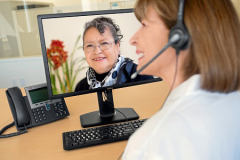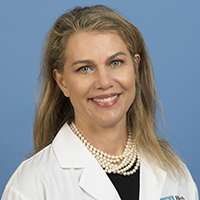UCLA Neurology Clinic Adopts Video Visits
April 17, 2020: FOR IMMEDIATE RELEASE

Concerns about coronavirus transmission have driven a massive, almost overnight shift to telemedicine. The UCLA Neurology Clinic was poised to make this shift, thanks to the efforts of nurse practitioner Melissa Reider-Demer, who has been a longtime advocate for telemedicine.
“She has been championing video visits, and thank goodness she has,” said clinic director Lillian Martinez. “Neurology was ahead of the game.”
Reider-Demer began promoting telemedicine more than 8 years ago, when she worked in neurosurgery. “It was so useful with postsurgical patients,” she said. “This was a way to avoid them having to come back into the clinic.” In 2018, she published data showing that most patients who received follow-up care by video were satisfied with the experience.

“With telemedicine, people tend to be more organized, because they’re less stressed,” Reider-Demer said. Patients don’t have to drive, park, navigate around campus, or wait to be seen. “With video visits, you bypass all that,” she said.
“Even though we had the possibility to do video visits, it had not been utilized as much,” said Martina Wiedau, MD, one of the clinic’s medical co-directors. Medicare didn’t cover video visits, for one thing, and physicians and patients were hesitant to abandon the familiarity of office visits. Now, COVID-19 has pushed everyone out of their comfort zone. Telemedicine allows patients to keep up with their neurology care while avoiding risk of infection.
Before the pandemic, the UCLA Neurology Clinic had already begun outfitting all their computers with webcams, and some staff and physicians had been trained in conducting video visits. When the governor announced the stay-at-home order, the clinic hit the ground running.
The clinic supports 17 programs, covering conditions such as stroke, migraine, epilepsy, and Parkinson’s disease, and treating about 115 patients per day. Immediately after the stay-at-home order, patient visits dropped to about half that number, but within a couple of weeks, video visits began to catch on.
“Our staff are working with the patients so that they are comfortable,” said Martinez. Many patients initially preferred to reschedule their visits, she said. “Now that it’s becoming clear that we don’t know when this will end, they’re saying ‘Ok, I’ll take that video visit.’”
Currently, around 80 patients per day log in for video visits, 15 have telephone appointments, and 10 are seen in person. One benefit of the shakeup, Martinez said, is that same-day appointments are now available in some cases. “ I would like patients and referring physicians to know we are here and available,” she said.

In a video visit, the physician begins by reviewing the patient’s history. “We take information from the patient about their symptoms and their medical history,” said Wiedau. “Then we do a more observational exam.” By watching the way the patient stands and walks, or by looking at muscle and skin changes, the doctor can assess how medications are working, or if the patient requires further treatment.
“We have to also tailor that to the circumstances of the COVID crisis,” said Wiedau. For instance, sometimes a doctor might wish to order follow up tests, to cover all bases. “If it’s not urgent, we may now delay that,” she said. “We will definitely still do things that are urgent to make sure patients get the correct diagnostics, and we don’t miss anything that needs to be taken care of.”
While in-person visits are available, the number of doctors and staff in the building is kept to a minimum, and safety measures are in place.
“When anybody enters the building, they are screened for fever and respiratory symptoms,” Wiedau explained. “Patients do not have to go through the usual check-in desk, but a nurse takes them immediately into a room.” Nobody lingers in a waiting area, and social distancing requirements are upheld.
“The staff have been amazing,” said Martinez. “I’m so proud of what they have been able to accomplish.”
Medical students are also staying at home, but clinic faculty are maintaining opportunities to continue their neurology training. The telemedicine setup allows for multiple people to connect remotely. With the patient’s consent, a student can log in and participate in video visits alongside a physician.
Beginning March 6, the Centers for Medicare and Medicaid Services (CMS) expanded access to telehealth on a “temporary and emergency basis.” It remains to be seen whether those programs will continue reimbursing healthcare providers for video visits after the pandemic subsides.
Reider-Demer said she hopes the silver lining of the crisis will be a widespread realization that telemedicine is a viable and satisfactory option for many medical issues. In addition to the neurology clinic, departments across UCLA Health are finding success with remote patient care. Overall, UCLA physicians currently conduct more than 2,000 video visits per day. “I definitely feel with this big swoop that telemedicine is going to sustain itself at a much higher level than it ever did before,” she said. “Maybe not to the capacity that it is now, but I don’t think it’s going to drop back to where it was.”
Media Contact
Marrecca Fiore
310-562-4161
[email protected]